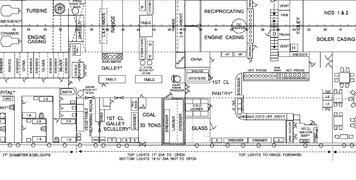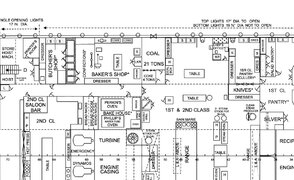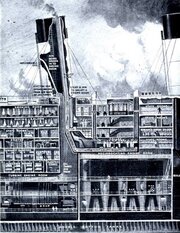Recently I posed an answer about "smoke" coming from the fourth funnel, in which I submitted that the funnel served as ventilation for the galley and some engineering spaces.
I decided to research possible sources of exhaust steam and "smoke" that might make an appearance, and came upon a puzzle...
In looking over the plans for "D" Deck, I found a 30 ton coal bunker or storage room in the 1st and 2nd class galley, just forward of the scullery on the starboard side.
It appears to accessed from the galley by regular doors.
Any insight as to what this coal was used for?
I can imagine that some of the galley equipment might be coal-fired... a grill or oven of some kind, perhaps... but THIRTY TONS seems to be rather a lot.
I find it hard to believe that much coal was used for cooking or required for a single crossing, although certainly plausible... and they must have had to replenish it regularly. It even appears to have it's own scuttle...on "D" deck level, as opposed to the boiler coal bunker scuttles on "F" deck.
Something I've never noticed before...
So, my questions are many:
1) What galley equipment would this coal have been used for?
2) Any thoughts on what might have been the rate of consumption?
3) Wouldn't consuming 30 tons of coal result in a fair amount of smoke (not billowing clouds, and probably faint enough...but there nonetheless)?
4) Is this scuttle visible in any TITANIC/OLYMPIC photos?
As stated in my previous reply, I'm guessing that some galley steam, non-condensable gases from the main condensers and perhaps auxiliary exhaust steam from the turbine room and sundry sources might have been exhausted through the fourth funnel as well. Combined with whatever is was that burned the galley coal supply, I'd imagine that under the right conditions, the fourth funnel might have given off a fair amount.
(NOTE: there is an item labeled "BOILER" just aft of the china storeroom, further inboard... but I assume this is a proper food "boiler" for boiling potatoes and such...not a "boiler" in the other sense. LOL)
ADDENDUM:
I discovered yet ANOTHER coal storage room/bunker on the same deck, nearly opposite of the one I discussed above, on the port side and just forward of the baker's shop... but this one has 21 tons capacity, for a total of over 50 tons of coal (in addition to 4 tons of coke). It, too, has it's own loading scuttle.
I decided to research possible sources of exhaust steam and "smoke" that might make an appearance, and came upon a puzzle...
In looking over the plans for "D" Deck, I found a 30 ton coal bunker or storage room in the 1st and 2nd class galley, just forward of the scullery on the starboard side.
It appears to accessed from the galley by regular doors.
Any insight as to what this coal was used for?
I can imagine that some of the galley equipment might be coal-fired... a grill or oven of some kind, perhaps... but THIRTY TONS seems to be rather a lot.
I find it hard to believe that much coal was used for cooking or required for a single crossing, although certainly plausible... and they must have had to replenish it regularly. It even appears to have it's own scuttle...on "D" deck level, as opposed to the boiler coal bunker scuttles on "F" deck.
Something I've never noticed before...
So, my questions are many:
1) What galley equipment would this coal have been used for?
2) Any thoughts on what might have been the rate of consumption?
3) Wouldn't consuming 30 tons of coal result in a fair amount of smoke (not billowing clouds, and probably faint enough...but there nonetheless)?
4) Is this scuttle visible in any TITANIC/OLYMPIC photos?
As stated in my previous reply, I'm guessing that some galley steam, non-condensable gases from the main condensers and perhaps auxiliary exhaust steam from the turbine room and sundry sources might have been exhausted through the fourth funnel as well. Combined with whatever is was that burned the galley coal supply, I'd imagine that under the right conditions, the fourth funnel might have given off a fair amount.
(NOTE: there is an item labeled "BOILER" just aft of the china storeroom, further inboard... but I assume this is a proper food "boiler" for boiling potatoes and such...not a "boiler" in the other sense. LOL)
ADDENDUM:
I discovered yet ANOTHER coal storage room/bunker on the same deck, nearly opposite of the one I discussed above, on the port side and just forward of the baker's shop... but this one has 21 tons capacity, for a total of over 50 tons of coal (in addition to 4 tons of coke). It, too, has it's own loading scuttle.
Attachments
Last edited:




